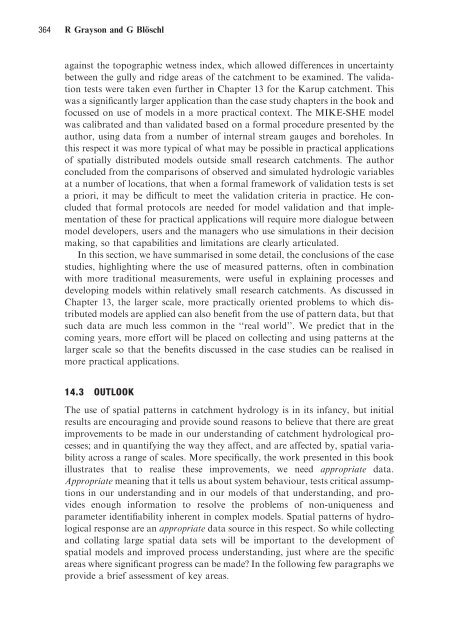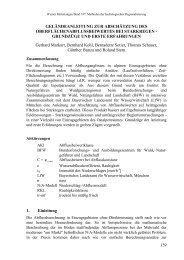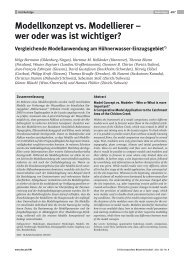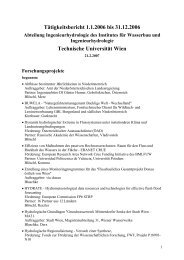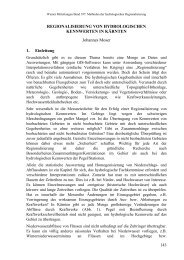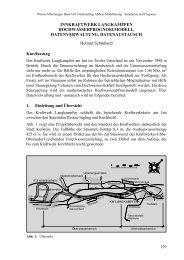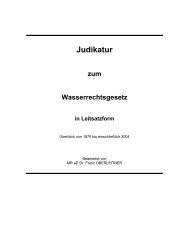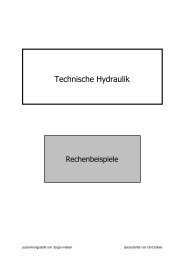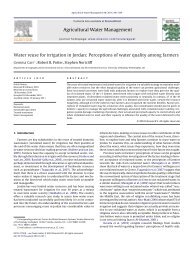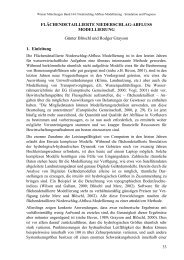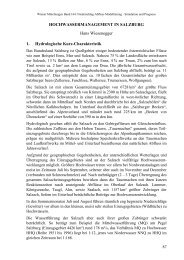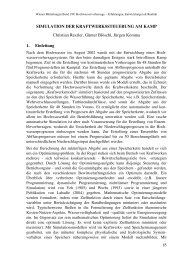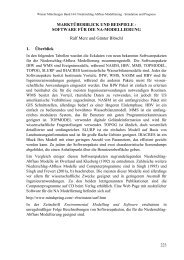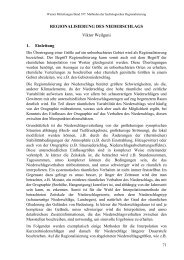Summary of Pattern Comparison and Concluding Remarks
Summary of Pattern Comparison and Concluding Remarks
Summary of Pattern Comparison and Concluding Remarks
Create successful ePaper yourself
Turn your PDF publications into a flip-book with our unique Google optimized e-Paper software.
364 R Grayson <strong>and</strong> G Blo¨ schl<br />
against the topographic wetness index, which allowed differences in uncertainty<br />
between the gully <strong>and</strong> ridge areas <strong>of</strong> the catchment to be examined. The validation<br />
tests were taken even further in Chapter 13 for the Karup catchment. This<br />
was a significantly larger application than the case study chapters in the book <strong>and</strong><br />
focussed on use <strong>of</strong> models in a more practical context. The MIKE-SHE model<br />
was calibrated <strong>and</strong> than validated based on a formal procedure presented by the<br />
author, using data from a number <strong>of</strong> internal stream gauges <strong>and</strong> boreholes. In<br />
this respect it was more typical <strong>of</strong> what may be possible in practical applications<br />
<strong>of</strong> spatially distributed models outside small research catchments. The author<br />
concluded from the comparisons <strong>of</strong> observed <strong>and</strong> simulated hydrologic variables<br />
at a number <strong>of</strong> locations, that when a formal framework <strong>of</strong> validation tests is set<br />
a priori, it may be difficult to meet the validation criteria in practice. He concluded<br />
that formal protocols are needed for model validation <strong>and</strong> that implementation<br />
<strong>of</strong> these for practical applications will require more dialogue between<br />
model developers, users <strong>and</strong> the managers who use simulations in their decision<br />
making, so that capabilities <strong>and</strong> limitations are clearly articulated.<br />
In this section, we have summarised in some detail, the conclusions <strong>of</strong> the case<br />
studies, highlighting where the use <strong>of</strong> measured patterns, <strong>of</strong>ten in combination<br />
with more traditional measurements, were useful in explaining processes <strong>and</strong><br />
developing models within relatively small research catchments. As discussed in<br />
Chapter 13, the larger scale, more practically oriented problems to which distributed<br />
models are applied can also benefit from the use <strong>of</strong> pattern data, but that<br />
such data are much less common in the ‘‘real world’’. We predict that in the<br />
coming years, more effort will be placed on collecting <strong>and</strong> using patterns at the<br />
larger scale so that the benefits discussed in the case studies can be realised in<br />
more practical applications.<br />
14.3 OUTLOOK<br />
The use <strong>of</strong> spatial patterns in catchment hydrology is in its infancy, but initial<br />
results are encouraging <strong>and</strong> provide sound reasons to believe that there are great<br />
improvements to be made in our underst<strong>and</strong>ing <strong>of</strong> catchment hydrological processes;<br />
<strong>and</strong> in quantifying the way they affect, <strong>and</strong> are affected by, spatial variability<br />
across a range <strong>of</strong> scales. More specifically, the work presented in this book<br />
illustrates that to realise these improvements, we need appropriate data.<br />
Appropriate meaning that it tells us about system behaviour, tests critical assumptions<br />
in our underst<strong>and</strong>ing <strong>and</strong> in our models <strong>of</strong> that underst<strong>and</strong>ing, <strong>and</strong> provides<br />
enough information to resolve the problems <strong>of</strong> non-uniqueness <strong>and</strong><br />
parameter identifiability inherent in complex models. Spatial patterns <strong>of</strong> hydrological<br />
response are an appropriate data source in this respect. So while collecting<br />
<strong>and</strong> collating large spatial data sets will be important to the development <strong>of</strong><br />
spatial models <strong>and</strong> improved process underst<strong>and</strong>ing, just where are the specific<br />
areas where significant progress can be made? In the following few paragraphs we<br />
provide a brief assessment <strong>of</strong> key areas.


